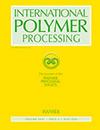Effect of additives on degradation of poly vinyl alcohol (PVA) using ultrasound and microwave irradiation
IF 1.9
4区 工程技术
Q4 ENGINEERING, CHEMICAL
引用次数: 1
Abstract
Abstract The degradation of polyvinyl alcohol (PVA) has been investigated using ultrasonic (US) as well as microwave (MW) irradiation techniques with the approach of process intensification based on different additives, such as Titanium Dioxide (TiO2), Sodium Lauryl Sulphate (SLS), Zinc Oxide (ZnO) and air. The effects of sonication time, initial polymer concentration, and temperature on the extent of reduction in viscosity have been thoroughly investigated using US as well as MW irradiation approaches. Basically, the degradation process has been optimized by utilizing two different ultrasonic reactors in a combined approach of ultrasonic horn and bath. The maximum extent of degradation of PVA was found to be 69.33% using MW irradiation with a required energy of 0.321 g/JL, and 62.47% using US horn with a required energy of 0.054 g/JL when operated at 0.1 g/L of TiO2 catalyst. The combination of US horn and US bath results in same degradation as 0.1 g/L of TiO2 catalyst with US horn. It has also been observed that the maximum degradation of PVA was obtained with a minimum treatment time of 3 min using MW irradiation, whereas the US horn required 40 min. Moreover, a lower extent of PVA degradation was obtained when additives were used, such as surfactants (SLS) and air. As a result, it can be inferred that the MW-assisted approach in the presence of process-intensifying additives/catalysts is the best approach for the degradation of PVA with a minimum energy consumption.添加剂对超声波和微波降解聚乙烯醇的影响
摘要采用超声波(US)和微波(MW)辐照技术,以二氧化钛(TiO2)、十二烷基硫酸钠(SLS)、氧化锌(ZnO)和空气为不同添加剂,采用强化工艺研究了聚乙烯醇(PVA)的降解。已经使用US和MW辐照方法彻底研究了超声处理时间、初始聚合物浓度和温度对粘度降低程度的影响。基本上,通过使用两种不同的超声波反应器,采用超声波喇叭和浴相结合的方法,对降解过程进行了优化。当在0.1g/L的TiO2催化剂下操作时,使用所需能量为0.321g/JL的MW辐射,PVA的最大降解程度为69.33%,使用所要求能量为0.054g/JL的US喇叭,PVA的降解程度为62.47%。US角和US浴的组合导致与具有US角的0.1g/L TiO2催化剂相同的降解。还观察到,使用MW辐射,PVA的最大降解是在3分钟的最小处理时间内获得的,而US喇叭需要40分钟。此外,当使用添加剂,如表面活性剂(SLS)和空气时,PVA的降解程度较低。因此,可以推断,在工艺强化添加剂/催化剂存在的情况下,MW辅助方法是以最小能耗降解PVA的最佳方法。
本文章由计算机程序翻译,如有差异,请以英文原文为准。
求助全文
约1分钟内获得全文
求助全文
来源期刊

International Polymer Processing
工程技术-高分子科学
CiteScore
2.20
自引率
7.70%
发文量
62
审稿时长
6 months
期刊介绍:
International Polymer Processing offers original research contributions, invited review papers and recent technological developments in processing thermoplastics, thermosets, elastomers and fibers as well as polymer reaction engineering. For more than 25 years International Polymer Processing, the journal of the Polymer Processing Society, provides strictly peer-reviewed, high-quality articles and rapid communications from the leading experts around the world.
 求助内容:
求助内容: 应助结果提醒方式:
应助结果提醒方式:


